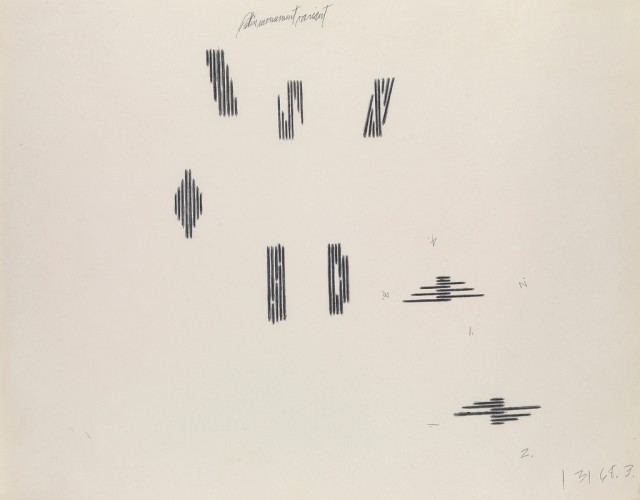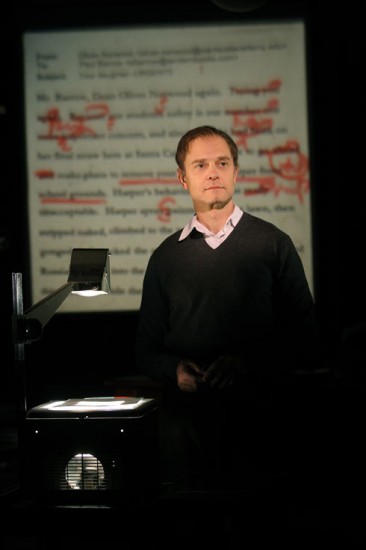Legendary British ska band the English Beat is doing double duty today at the CMJ Music Marathon, with Dave Wakeling playing an acoustic set at 5:00 at Spike Hill in Brooklyn, followed by what should be an electrifying full-band gig at B.B. King’s with the Paul Collins Beat opening up. The English Beat is touring behind the massive multi-CD/DVD boxed set Special Beat Service, which recounts the history of this highly influential group that still knows how to kick out the jams.
twi-ny: archive of past events
CATALPA VIDEO OF THE DAY: “GOODBYE SERENADE” BY THE REBEL LIGHT
Brothers Alan and Jarrett Steil, who grew up in Montauk and previously teamed up to form the duo Suddyn, have recruited drummer Brandon Cooke for the trio the Rebel Light. As the band prepares its debut EP, you can check out three groovy new anthemic indie tunes, “Wake Up Your Mind,” “My Heroes Are Dead,” and “Goodbye Serenade.” The Rebel Light will kick things off Saturday on the Second Stage at the Catalpa Festival on Randall’s Island, on a bill with the Sheepdogs, Zola Jesus, Hercules and Love Affair, TV on the Radio, the Black Keys, and others. To find out more about Catalpa, read our interview with the festival’s founder, Dave Foran, here.
DAN FLAVIN: DRAWING

Dan Flavin, “eight ‘monuments’ for V. Tatlin,” black ballpoint ink on white paper (collection of Stephen Flavin)
Morgan Library & Museum
225 Madison Ave. at 36th St.
Tuesday – Sunday through July 1, $10-$15 (free Friday 7:00 – 9:00)
212-685-0008
www.themorgan.org
“Dan Flavin: Drawing” is a revealing, illuminating look at a little-known, fascinating side of the innovative New York-based light sculptor. On view at the Morgan through July 1, the exhibit focuses on charcoals, pencils, inks, and watercolors made by Flavin over four decades, from preparatory drawings for his fluorescent sculptures to minimalist landscapes, portraits, and depictions of one of his favorite subjects, sailboats along the Hudson River and out on Long Island. Flavin’s use of line in his drawings is striking, particularly in the sailboat sketches and planned monuments for Russian avant-gardist Vladimir Tatlin. Flavin also pays tribute to a wide range of writers and artists in these works, many made in small three-by-five lined notebooks, including Alexander Calder, Apollinaire, Donald Judd, James Joyce, Barnett Newman, Paul Cézanne, Vincent van Gogh, Sol LeWitt, Titian, Jasper Johns, Michelangelo Antonioni, and Constantin Brancusi. The exhibition ranges from such abstract, blotchy drawings as “The Act of Love” and “untitled (tenements in the rain)” to the Japanese-inspired “a mechanical interior” to the architectural “from no. 1 of Dec 19, 1963 (in pink)” and “(to the young woman and men murdered in Kent State and Jackson State Universities and to their fellow students who are yet to be killed),” which create intriguing spaces on paper.

Dan Flavin, “untitled (in honor of Harold Joachim) 3,” pink, yellow, blue, and green fluorescent light, 1977 (photo by twi-ny/mdr)
Several of the later pieces that more directly relate to his light sculptures were actually made by his first wife, Sonja, and his son, Stephen, supervised by Flavin, who died in 1996 at the age of sixty-three. Also on display are nearly fifty works from his personal collection that reveal his many influences, with drawings by such Hudson River School painters as Sanford Robinson Gifford, John Frederick Kensett, and Aaron Draper Shattuck, such Japanese masters as Hiroshige and Hokusai, and such friends and colleagues as Judd, Robert Morris, and LeWitt, in addition to Toulouse-Lautrec, Hans Arp, George Grosz, Piet Mondrian, and Hans Richter. To put it all in perspective, the Morgan has installed two of Flavin’s light sculptures. In the upstairs Engelhard Gallery, “untitled (to the real Dan Hill) 1a” leans against a corner near the main entrance, an eight-foot-high single construction giving off pink, yellow, green, and blue fluorescent light, in stark contrast to the mostly black-and-white drawings throughout the rest of the room. But the real gem is “untitled (in honor of Harold Joachim) 3,” which deservedly stands alone in the downstairs Clare Eddy Thaw Gallery, a beautiful corner grid of six horizontal lights facing out, six vertical lights against the wall, creating soft, meditative glows that are at the heart of Flavin’s raison d’être.
PATANG (THE KITE: HOLD ON TO YOUR HAPPINESS)

Hamid (Hamid Shaikh) looks to the skies in poignant Indian family drama (photo courtesy Khushi Films)
PATANG (Prashant Bhargava, 2011)
Cinema Village
22 East 12th St. between University Pl. & Fifth Ave.
Opens Friday, June 15
212-924-3363
www.cinemavillage.com
www.patang.tv
 Born and raised in Chicago, Prashant Bhargava returns to his cultural heritage in his debut feature film, the tender and moving Patang. Set during the traditional Uttarayan kite festival held every January 14 in India, the film follows a family celebrating the event in their home in Ahmedabad, where they are joined by Jayesh (Mukund Shukla) for the first time in five years. A successful businessman who moved to Delhi, Jayesh has brought his daughter, Priya (Sugandha Garg), with him, a young woman whose burgeoning sexuality has Jayesh playing the overprotective father. Although most of the family is happy to see him, he finds that he is still at odds with his nephew Chakku (Nawazuddin Siddiqui), who blames Jayesh for his father’s death. Chakku also resents his uncle for having left the family home for the big city. While Jayesh tries to convince his sister-in-law, Sudha (Seema Biswas), and mother (Pannaben Soni), Ba, that Delhi would be good for them as well, Priya flirts with Bobby (Aakash Maherya), a local man she met in an electronics store, and Chakku guides a small group of young boys, particularly Hamid (Hamid Shaikh), through some of the harder sides of life. Bhargava wrote, directed, and edited Patang and also operated one of two handheld HD cameras, along with cinematographer Shanker Raman, giving the film a documentary-like feel that is enhanced by a cast that consists primarily of nonactors in heavily improvised scenes based on the script. The neorealist film pits the traditional against the new, old against young, and rich against poor as the night sky ultimately comes alive with colorful kites, fireworks, and glowing lanterns called tukkals. The film also features an evocative score by Mario Grigorov and songs by Pankaj Awasthi and others that continue the subtle exploration of India’s past, present, and future as seen through the eyes of one tight-knit family.
Born and raised in Chicago, Prashant Bhargava returns to his cultural heritage in his debut feature film, the tender and moving Patang. Set during the traditional Uttarayan kite festival held every January 14 in India, the film follows a family celebrating the event in their home in Ahmedabad, where they are joined by Jayesh (Mukund Shukla) for the first time in five years. A successful businessman who moved to Delhi, Jayesh has brought his daughter, Priya (Sugandha Garg), with him, a young woman whose burgeoning sexuality has Jayesh playing the overprotective father. Although most of the family is happy to see him, he finds that he is still at odds with his nephew Chakku (Nawazuddin Siddiqui), who blames Jayesh for his father’s death. Chakku also resents his uncle for having left the family home for the big city. While Jayesh tries to convince his sister-in-law, Sudha (Seema Biswas), and mother (Pannaben Soni), Ba, that Delhi would be good for them as well, Priya flirts with Bobby (Aakash Maherya), a local man she met in an electronics store, and Chakku guides a small group of young boys, particularly Hamid (Hamid Shaikh), through some of the harder sides of life. Bhargava wrote, directed, and edited Patang and also operated one of two handheld HD cameras, along with cinematographer Shanker Raman, giving the film a documentary-like feel that is enhanced by a cast that consists primarily of nonactors in heavily improvised scenes based on the script. The neorealist film pits the traditional against the new, old against young, and rich against poor as the night sky ultimately comes alive with colorful kites, fireworks, and glowing lanterns called tukkals. The film also features an evocative score by Mario Grigorov and songs by Pankaj Awasthi and others that continue the subtle exploration of India’s past, present, and future as seen through the eyes of one tight-knit family.
TERESA’S ECSTASY
Cherry Lane Theatre
38 Commerce St.
Through April 1, $61
212-989-2020
www.cherrylanetheatre.org
Something strange happened after we returned to our seats following a brief stroll outside in the beautiful fresh air of a lovely end-of-winter evening during intermission of Teresa’s Ecstasy, running at the Cherry Lane through April 1. It was like we had walked back into a different play. What had been a warm, intimate, and engaging story suddenly turned acidic, mean-spirited, and convoluted. Thank goodness the dreadful second act is much shorter than the tender first. Playwright Begonya Plaza stars as Carlotta, a writer who has returned to Barcelona to get her husband, Andrés (Shawn Elliott), to finally sign their divorce papers and to research a magazine story she is doing on St. Teresa of Avila, a sixteenth-century Carmelite nun of Jewish ancestry who, as Carlotta notes, “overcame death-threatening illnesses, defamations, ethnic and religious genocide by the Spanish Inquisition, reformed her own church, founded over a dozen monasteries, and all the while writing works, masterworks, of literature.” But Andrés, a painter, has no time for organized religion and mysticism. “She’s part of an institution that excludes, kills, exploits, and brainwashes people into complacency,” the painter says. “God is an invention to control the masses for power and wealth.” While that is not necessarily an original argument, the debate works well between the passionate Carlotta and the gentle, easygoing Andrés, even when they are joined by Carlotta’s editor, Becky (Linda Larkin), a sharp-dressed elitist blonde who is immediately at odds with Andrés. But when Becky and Carlotta return from Avila in the second act, they are transformed in such a way that is utterly unbelievable, delivering clichéd diatribes on sex and religion as Andrés turns nasty and rotten, completely undermining everything that was so well established in the first act. Elliott, who had been in the midst of an unforgettable performance, his every movement a work of art, from his arms, hands, and head to his soft eyes that gaze into the audience, stumbled badly over one line, as if he couldn’t get himself to say it out loud in public. Meanwhile, Plaza forces in references to Cat Stevens and Federico García Lorca that feel out-of-place and downright unnecessary. Directed by Will Pomerantz, Teresa’s Ecstasy features tantalizing foreplay that fails to reach a satisfying conclusion.
CREATIVE VOICES OF ASIA: WAYANG KULIT
JAVANESE WAYANG KULIT, SHADOW-PUPPET THEATER OF INDONESIA
Asia Society
725 Park Ave. at 70th St.
Friday, March 16, 6:30
212-288-6400
www.asiasociety.org
Master dhalang Ki Purbo Asmoro will make a rare appearance at Asia Society on Friday night, performing wayang kulit, Javanese shadow-puppet theater. Purbo Asmoro, known for combining the traditional with the innovative, will be accompanied by a full Javanese gamelan orchestra made up of members of his Java troupe, Mayangkara, as well as New York City’s own Gamelan Kusuma Laras. The three-hour production begins twenty minutes early with welcoming music and will be presented with live English translation. The audience is encouraged to move around and see the show from both sides of the shadow screen, known as a kelir, so they can experience more of this unique form of storytelling. The puppets might be flat objects, but Purbo Asmoro fills them with emotion, energy, and spirit. The performance is part of the “Creative Voices of Muslim Asia” series, which continues April 26 with “New Sufi Music of Pakistan,” a concert with Arif Lohar and Aroog Aftab. And if you can’t score a ticket to this hot event, you can watch the live webcast here.
CLOSE UP SPACE
Manhattan Theatre Club
New York City Center Stage 1
Through January 29, $80
www.closeupspacetheplay.com
As Close Up Space begins, senior editor Paul Barrow (David Hyde Pierce) is taking a red marker to letters he received telling him that his troublesome daughter is being expelled from school. Unfortunately, someone should have taken a red pencil to Molly Smith Metzler’s mess of a script. The Manhattan Theatre Club production, running at City Center’s lovely Stage I space, centers on Barrow, an old-fashioned editor more concerned with The Chicago Manual of Style than Dr. Benjamin Spock’s Raising Children in a Difficult Time. Following his wife’s tragic death several years earlier, Barrow has isolated himself from friends and relatives, immersing himself in his work instead of trying to fix his fractured relationship with his teenage daughter, Harper (Colby Minifie). He’d rather spend his time battling with his star author, the demanding, tough-talking Vanessa Finn Adams (Rosie Perez), than dealing with Harper, who suddenly shows up one day speaking only Russian, which unnerves intern Bailey (Jesssica DiGiovanni) while energizing office manager Steve (Michael Chernus), who has been sleeping in a tent at Tandem Books because of a breakup with his beloved pit bull. Barrow might know how to fix fiction, but he’s at a loss when it comes to repairing real life. Hyde Pierce does an admirable job trying to keep the ship steady with the support of director Leigh Silverman (Chinglish, Well), but even the Tony-winning actor (Curtains) seems dismayed by the cringe-inducing ending. Metzler (Elemeno Pea, Training Wisteria, Carve) tries to fill the eighty-five-minute show with absurdist comedy, but the Bailey character is superfluous (as Barrow would say, “Delete, close up space”) and Steve, though likable in general, is way too over the top (“Au — perhaps tone down?”). And though it’s fun to hear Perez (Frankie and Johnny in the Clair de Lune) spout Shakespeare (“Au/Ed — relevance?”) and discuss fiddlehead ferns, her character often feels forced (“Au — necessary? cliché ok?”). Todd Rosenthal’s scenic design appropriately evokes an old publishing house holding on to the past in this modern age, but the rest of Close Up Space is in desperate need of a major revision.


